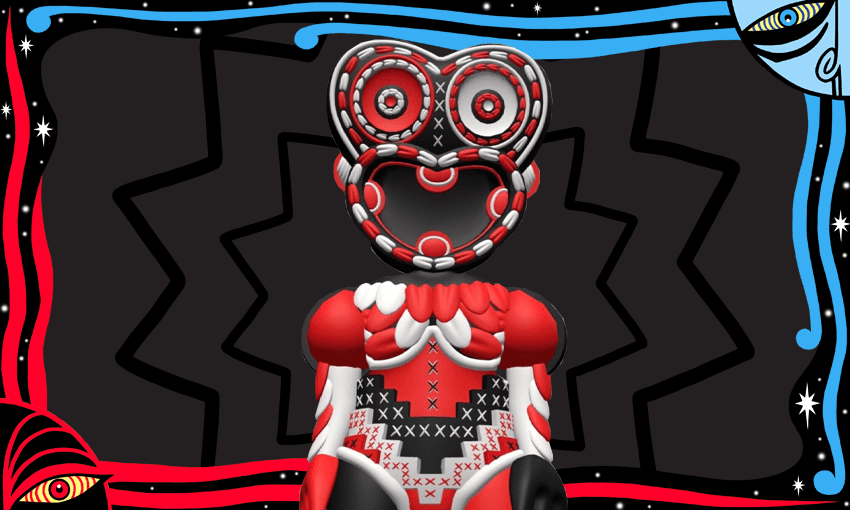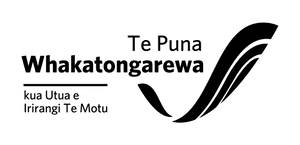Meet Auraki, a digital character designed by multidimensional artist Hōhepa Thompson to enter media companies and educate them in tikanga Māori. And if he’s not invited in he’ll scale the walls and peer in the windows.
Many media outlets in Aotearoa pay lip service to being culturally aware, but how deep is their commitment?
This is the question being posed by Hōhepa Thompson (Ngāti Kahungunu ki Wairarapa, Toa Rangatira and Ngāi Tahu) through a tech-based art demonstration.
Better known by his artist name The Hori, Thompson’s latest project, We Are the Mainstream, takes us into the future with Auraki, an augmented reality character created to support media organisations with cultural competency and awareness of te ao Māori.
Listen to Nē? kōrero with Hōhepa Thompson on Apple Podcasts, Spotify or your favourite podcast provider.
“There are constant fuck-ups that happen with headlines and you wonder, how did that get through? This isn’t to whakaiti those people, yes it starts with a challenge, we throw that wero at them first but it definitely comes from a place of manaaki, like you’re better off knowing those things,” says Thompson.
The multidimensional artist based in Ōtaki has a habit of raising topics that some people might find difficult, such as exploring our colonial past and the ongoing impacts of colonisation on the attitudes and actions of people in Aotearoa today.
Recently he’s been raising awareness around the country, and internationally, through an initiative called This is Aotearoa.
With a background in studying digital media at university, the artist uses humour, art and technology to hold conversations from a Māori perspective.
The catalyst for his latest challenge was at an exhibition that he did with artist Tame Iti (Tūhoe) where, Thompson says, a media reporter revealed his lack of cultural awareness. “I could tell Tame wasn’t vibing with the guy. At the end the journalist said, ‘it’s great to get these Māowry stories into mainstream media’. Tame then turned to him and said, ‘We are the mainstream’. That’s always stuck with me,” says Thompson.
The new project takes that idea and expands upon it. “From a te ao Māori perspective, we are the stream, we are the awa, we allow you to swim in our streams but just remember, ko mātou kē te auraki, we are the mainstream,” says Thompson.
Focusing particularly on media, Thompson says it’s no secret how Māori have been mistreated over the years. “If you take Stuff for example, who made a public apology a couple of years ago, maybe we could look at other media agencies and flip the script and ask them to be more transparent around that,” says Thompson.
Through that process of reflection, Auraki was formed. A 3D augmented reality (AR) character based on carved Māori figures, which can be downloaded via an app, it is envisioned that Auraki will be welcomed into these organisations and housed in a central area where it can interact with staff by answering questions through an app.
“I see it like te ao Māori is the IRD, Auraki is the accountant and these media agencies are the clients. So what can Auraki do to help in a more creative way to give insight into our world and give them some tips on why Māori think the way we do?” says Thompson.
Using AR, Thompson has mapped the buildings of six different media companies in Aotearoa. For the organisations who don’t welcome Auraki, the character will be outside knocking on the windows and scaling the walls until a face-to-face interaction is possible.
“Once the piece is welcomed into the building, we leave the taonga with them for a couple of months where it actually learns from its environment,” says Thompson.
Each of the media organisations who participate will have their own unique-looking Auraki with its own colours and movements, another artistic element through an AR collaboration with toi.world and iSPARX.group.
Thompson donned a bodysuit and used motion capture technology to bring his idea to life. “There are different actions that it makes, it can walk up and down the building, so it’s constantly doing things. Once it’s in the space, it acts like a pou in their whare,” says Thompson.
Acknowledging that tikanga are expressed differently at most marae, Thompson understands that each organisation will have their own strategies and protocols as well as their own unique culture.
“It represents te ao Māori, you might not be able to see it but it’s there, so I love that part of it, and I love the part that your media (phone) is the thing that gives you your lens to that world,” says Thompson.
Auraki strives to gauge where staff within the organisation are at as a collective in terms of cultural understanding of te ao Māori. “It starts off with questions like, ‘do you speak te reo Māori?’ It’s as simple as that. Some of the questions are, ‘Have you read any of the articles of the Treaty?’ which many people haven’t,” says Thompson.
For him, the art is about getting Auraki inside the door and the goal is to support the organisations with their own aspirations of cultural competency. “It’s hard to create real, authentic competencies when you’re dealing with this kind of kaupapa. This is long-game stuff,” says Thompson.
After the two-month trial run, the data will be collated and analysed by Thompson and his team who will look to tailor some specific recommendations and allow the organisations to keep Auraki on. “It kind of becomes like a cultural consultant within their space,” he says.
While the demonstration proposal has been sent to selected media organisations, not all have signed up just yet. “The thing about working in that virtual space is that Auraki can sit there forever. If you don’t want to be involved, kei te pai, but it will sit there forever and it will constantly want to come in and be invited in.”
The We are the Mainstream art demonstration will launch on the 28th of November at six separate sites in Tāmaki Makaurau and will be opened to the public on December 2.
Follow our te ao Māori podcast Nē? on Apple Podcasts, Spotify or your favourite podcast provider.
This is Public Interest Journalism funded through NZ On Air.

